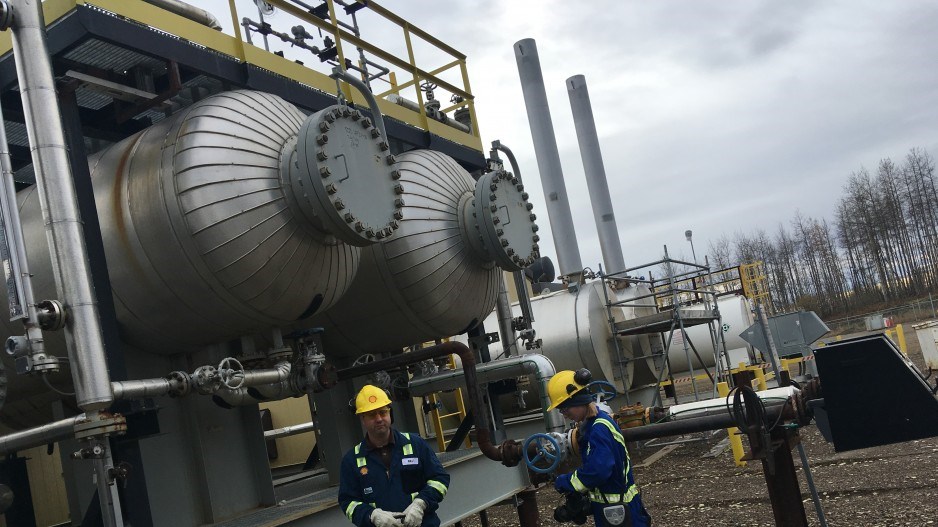A liquefied natural gas industry can be developed without blowing B.C.’s carbon diet, but only if the industry is extensively electrified, according to a new Clean Energy BC white paper.
“In all but the most aggressive decarbonization pathway scenarios, liquid and gaseous fossil fuels – including liquid natural gas (LNG) – will continue to play a leading role well into the decades of this century,” the white paper states.
But without extensive electrification, an LNG industry would make it difficult for B.C. to meet its greenhouse gas (GHG) reduction targets, the white paper states.
It estimates “extensive electrification” of the Montney region in northeastern B.C., where the natural gas for the $40 billion LNG Canada project would be produced, could reduce upstream emissions by 60%.
Some electrification of the natural gas sector in northeastern B.C. has already occurred, as a recent tour of Shell Canada’s Groundbirch operation showed.
And more is on the way, thanks to BC Hydro’s new $298 million Peace Region Electricity Supply (PRES) project, which is now in early construction.
Shell’s Groundbirch region, south of Fort St. John, includes 500 natural gas wells, two large natural gas processing plants and two smaller ones.
The newest and largest, the Saturn plant, is something of a showpiece for the industry. It is fully electric, with power transmission lines provided through the Dawson Creek-Chetwynd Area Transmission (DCAT) project.
According to the BC Oil and Gas Commission, 13 of 110 gas plants in B.C. are electrified. Clean Energy BC estimates that electrifying the Peace region’s gas sector has already reduced emissions by two million tonnes of carbon dioxide equivalent (CO2e).
Running on electric compressors reduces the Saturn plant’s emissions by an estimated 150,000 tonnes of CO2e per year, according to Shell. Shell is also using the latest technology to reduce emissions of GHGs, including methane, in some of its newer-generation well pads. Shell is using electric actuators, for example, on its well pads. These replace pneumatic actuators, which use natural gas to open and close valves, resulting in methane emissions.
“There’s no venting from these controllers,” said Chang Liu, Groundbirch surveillance engineer.
Shell is now looking to retrofit some of its older well pads with electric actuators. The newer well pads also run on electricity through a combination of solar panels and thermoelectric generators. Shell’s drill rigs also use natural gas instead of diesel, which lowers emissions.
Shell’s 500 wells and four processing plants produce 500 million cubic feet of gas per day.
Currently, most of the gas Shell produces from Groundbirch goes into the TransCanada Corp. (TSX, NYSE:TRP) mainline, which moves gas to Eastern Canada and the U.S.
But once the $14 billion LNG Canada plant in Kitimat is in operation, that gas will shift west to Kitimat via the Coastal GasLink pipeline, said Rej Tetrault, general manager for Shell’s Groundbirch operations.
He expects Shell will need to increase its production by about 200 million cubic feet per day to meet its obligations to deliver gas to LNG Canada.
That will require some new wells being drilled and new gas plants being built, or the expansion of existing ones, unless Shell opts to simply buy the extra gas from other producers in the region.
By the time any new plants are built, or old ones expanded, additional hydro power will be available through the PRES project, which is slated for commissioning in 2021, so any new gas plants or plant expansions could tap into the grid.
Jae Mather, executive director of Clean Energy BC, said the PRES project would provide access to 600 megawatts of power for the region, which will not be enough to provide the kind of extensive electrification that the region will need if B.C. is to meet its climate change targets.
The LNG Canada project is said to have one of the lowest emissions intensities of any large LNG plant in the world.
Part of that calculation is the emissions intensity of the natural gas produced in the Montney by Shell and some of its LNG Canada partners, including Mitsubishi, which is also part of the Cutbank Ridge Partnership with Encana Corp. (TSX:ECA).
Montney gas has a low carbon content to start with – about 1% compared with Horn River gas’ 12%, according to a Delphi Group report.
Shell also claims that the methane emissions from its Groundbirch operations are just 0.1% of its total product output – a 10th of the average methane emission rate calculated by the U.S. Environmental Protection Agency for American natural gas production.
Mather is skeptical that it can be that low.
“It is possible, and if there’s going to be a company that’s going to do it, I believe that Shell would be one of the ones because they’re the global leader, but it seems to be a bit early to say this is what we’re going to be when there’s no evidence to support that.”
See related story: LNG Canada unlikely to spark a fracking frenzy.




